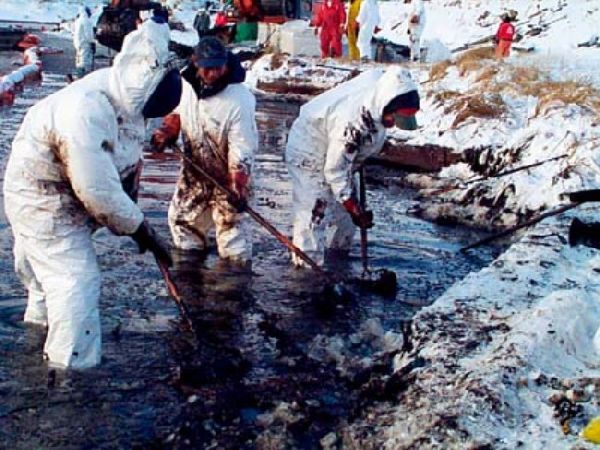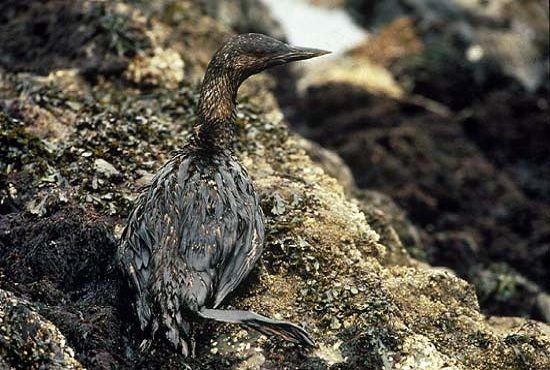30 Years after the Exxon Valdez
On March 24, 1989, the oil tanker Exxon Valdez ran aground in Alaska’s Prince William Sound, spilling about 11 million gallons of North Slope crude oil. Much has changed in oil spill prevention and response since then. For more information, see DEC's March 22, 2019 press release, DEC Notes Improvements In Spill Response Since EVOS.
- Prevention
- Response
- More Information

Tanker Escorts
March 1989
Tug escort only through the Valdez Narrows.
March 2019
The Ship Escort/Response Vessel System (SERVS) escorts tankers with five state-of-the-art tugs. All Trans Alaska Pipeline System shippers must use SERVS as their spill response contractor. SERVS is one of many response contractors which must be registered with DEC.

Support Vessels
March 1989
No support vessels.
March 2019
An ocean rescue tug stationed at the Hinchinbrook Entrance to Prince William Sound (PWS) since 1997 is one of five highly maneuverable prevention and response vessels to assist tankers.

Tanker Transport
March 1989
No requirement for double hull tankers.
March 2019
Complete phase-in of double hull tankers required by 2015. All but one of the pipeline tankers operating in PWS are double-hulled; the majority have backup propulsion systems.
Pilot Training
March 1989
No extra training required of tanker officers, tug officers, and marine pilots
March 2019
Advanced training for tanker officers, tug officers, and marine pilots; marine safety committee monitors and evaluates tanker operations.
Ship Tracking/Protection
March 1989
Ship tracking limited to near Bligh Reef
March 2019
U.S. Coast Guard-controlled ship tracking system throughout PWS and 60 miles into the Gulf of Alaska; high-tech information system required on ships; special operating procedures for approaching and transiting Valdez Narrows; ice radar warns ships of ice navigation hazards.

Planning
March 1989
Basic spill prevention and response plan developed by Alyeska was inadequate, and implementation during the spill was slow.
March 2019
Detailed oil discharge prevention and contingency plans developed by individual shippers and Alyeska, and approved by DEC. Alyeska must lead the initial fast response in PWS.
Contingency plans must meet response planning standards - set in statute - that describe the ability to clean up a large spill within 72 hours. Response must incorporate leading technology.
State Oversight
March 1989
Limited State oversight of Valdez marine terminal and tanker operations by three DEC generalists in Valdez.
March 2019
Comprehensive State oversight of marine terminal and tanker operations - four DEC spill prevention and response regulators are located in Valdez.

Equipment Locations
March 1989
No response equipment stockpiled outside of Valdez.
March 2019
Equipment staged in Valdez, Tatitlek, Cordova, Chenega and Whittier.

Equipment on Hand
March 1989
Less than five miles of containment boom to corral oil in Prince William Sound.
No fire boom or systems to ignite and burn the contained oil.
2,475 gallons of dispersants to lessen the impact of oil on shorelines, but no application systems immediately available.
March 2019
Over 50 miles of different types of containment boom stationed in PWS.
3,600 feet of fire boom with helicopter-carried igniter systems.
74,940 gallon dispersant stockpile, with fixed wing, helicopter and ship application systems.

Oil Recovery
March 1989
13 oil skimming systems with a combined recovery capacity of over 27,800 barrels of oil in 72 hours.
One barge with 12,000 barrels of storage capacity for recovered oil stationed in Valdez.
March 2019
Over 120 skimming systems to pick up oil from within containment boom and store it in barges and other vessels. This equipment can recover over 300,000 barrels of oil in 72 hours.
Eight barges strategically located throughout PWS with nearly 850,000 barrels of storage capacity for recovered oil and 54 smaller barges for near-shore work.

Trained Responders
March 1989
Limited number of trained spill responders.
March 2019
Teams dedicated to spill response and Ship Escort/Response Vessel System (SERVS).
Hatchery Protection
March 1989
No salmon hatchery protection plans or staged spill response equipment at hatcheries.
March 2019
Hatchery protection plans and stockpiled equipment for all five PWS hatcheries and Afognak Island's Kitoi Bay hatchery.

Citizen / Community Involvement
March 1989
No organized citizen involvement in plan development and oversight.
No plan to involve local fishing vessels in a response to a spill.
March 2019
Prince William Sound and Cook Inlet regional citizen advisory councils created.
Regional Stakeholder Committee involved in annual major PWS drills to ensure local community needs are addressed.
A program to train fishing vessel personnel in Prince William Sound, lower Cook Inlet and Kodiak, and incorporate vessels into a response strategy.

Wildlife Rescue
March 1989
No established wildlife rescue programs.
March 2019
Wildlife response plan with rescue and rehabilitation equipment in place.

Practice Drills
March 1989
No drills to practice response to a major spill.
March 2019
Major spill drill conducted annually, with frequent smaller drills.

Managed Response
March 1989
No consistent management structure for spill response.
March 2019
A Unified Command/Incident Command structure, patterned after responses to wildfires, adopted by DEC, Coast Guard, SERVS and shippers to lead spill cleanup.
Communications
March 1989
Limited State radio communications for spill response command in PWS.
March 2019
Advanced radio communications system with capability to cover PWS and Cook Inlet, with some reach into the Gulf of Alaska.
Exxon Valdez Oil Spill Trustee Council
The Trustee Council was formed to oversee restoration of the injured ecosystem through the use of the $900 million civil settlement. The Council consists of three state and three federal trustees (or their designees). The Council is advised by members of the public and by members of the scientific community.
NOAA Fisheries Office of Exxon Valdez Oil Spill (EVOS) Damage Assessment and Restoration


 Indicates an external site.
Indicates an external site.